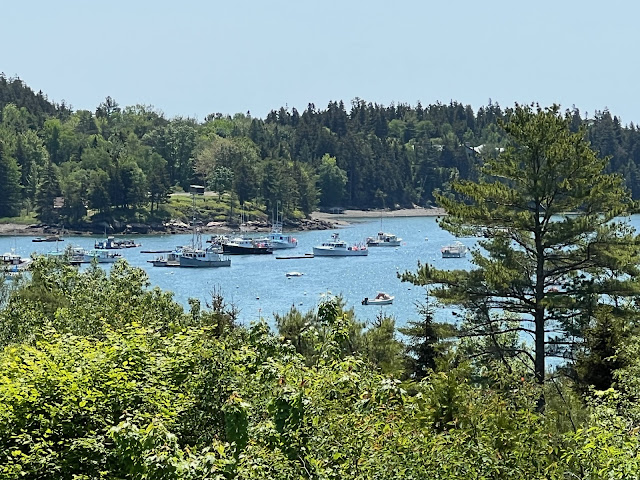Charlotte and I and our friend Gertie went to the British Virgin Islands in January. It was my idea. After getting home in one piece from our summer cruise in Maine, I thought it would be fun to go on a sailing trip. As opposed to the last two years failed attempts to go to Antarctica this year it would be somewhere guaranteed to be warm. So, to that end I planned a week on a 46’ sailboat and to be cautious I asked for a skipper.
I am not usually the trip planner but other than the air travel (probably the hardest part) I organized the cruise. There were a few hiccups due to their headquarters in Florida being ravaged by a couple of hurricanes, but eventually the payments were sent and the cruise confirmed.
To be on the safe side we stayed at the Ohare Hilton the night before the 5AM flight to Miami and we arrived in Road Town, Tortola a day early. You all know the feeling: bundled up in down with thickened blood from living in the artic, then stepping off the plane onto a sizzling tarmac with beautiful lilting voices beckoning welcome to their palm tree covered islands.
It is hard to beat and only 2000 miles from our ice encrusted backdoor stairs. What’s not to like. We checked in, stared out the open glass doors onto anchored sailboats and behemoth cruise liners, and thought of our good fortune to feel warm breezes in January. That night a waterside Italian restaurant was the setting for anticipatory talk of the next day’s adventure. I even had a Negroni, a thing I have never ordered in my 71 years thus far on earth. I guess the warmth went to my head even before I swilled the concoction down.
One of the weird things about chartering a boat is that we are responsible for provisioning it. Our brain’s strained at the thought of buying food and drink for three adults for seven breakfasts, lunches and dinners. There were several choices: the market in the marina, the French Deli just outside the gate or the Rite-Way a couple of blocks away.
My profession has left me with a tendency at having all the right answers and in making decisions without much consultation. Add to this a lack of patience (I blame my Sicilian heritage for this trait) for other’s decision making processes and I went through a bit of a hissy fit. Basically, my traveling companions ignored me and did what they wanted to, which was taking a ride to Rite-Way with a side diversion to the French Deli.
To push a cart full of food, wine, beer and water engenders odd feelings of satiety and famine. At one moment I wanted to unload half the food and a moment later needed to add a half more. In the end, there was barely any left for the skipper and the boat cleaners to take home.
The charter began the night before. At 6PM the boat was available to board. Then we were standing on the dock looking at a 46’ of boat pointing out in front of us. I have been boarding boats since I was eleven years old and that fact does not diminish the thrill. It does not matter if it is a rubber dinghy or a Viking cruise ship my stomach is a little off with anticipation. I cannot wait to go exploring.
Now, here is where things began to go a little wrong. I have expectations and immediately they were not met. The boat was not spick and span. The equipment had seen better days. The cockpit cushion was wrong and the linens were in tatters. The next day I repeatedly tried to get someone to go over the checklist with me. It was sitting right there, beckoning to be checked off and be signed by me and the skipper. But to no avail we loosened the lines and headed into the deep blue sea, after that is, we passed in the lee of two of the largest cruise ships I have ever seen.
We were off, I girded my loins and hoped for the best. And the next seven days were a bit of both. Of course, the boat needed servicing immediately, which delayed the next day’s trip. I began to compiled a list that ended with 16 bullet points documenting the boat’s foibles.
The skipper though, was a well-mannered local 25 year old who had an encyclopedic knowledge of his natural world. He brought his fishing pole and trolled behind the boat as we cruised. He even caught a bonito and cooked it on the grill with wood he salvaged from the mangrove. We met his nephew, his Uncle Willard and his sister. We were privy to a celebration of a local hero’s premature death complete with an embarrassingly (for us old people at least) suggestive dance competition where two of the participants split a purse of two thousand dollars.
As the week progressed the wind picked up and the weather became squally. Each time I thought to raise the sails the wind was directly in front of us. I have no excuse except for growing spoiled by Carrie Rose’s turnkey operation and my laziness.
Despite the vagaries of the boat, it was a joy to be in warm water and air. On our day out swimming on a pure white sand beach we each got tumbled in the surf and suffered bumps and bruises. Boy, we were sore the next day. No matter, all is right in the world when the world is green and lush and warm and blue. You ask would I do it again and to that I say yes . . . just not with this company.



























.jpeg)






